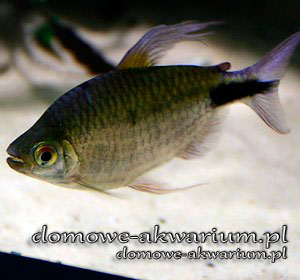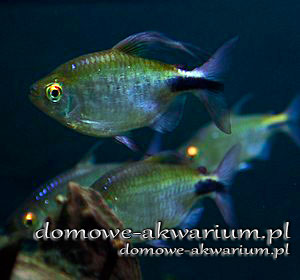
| Species | Long Finned Tetra |
|---|---|
| Other names | Longfin Tetra |
| Latin Name | Bryconalestes Longipinnis |
| Family | african tetras |
| Origin | Afryka |
| Length | 12 cm |
| Temperature | 23 - 27°C |
| Water Hardness | soft - medium hard |
| pH | 6.5 - 7.5 |
| Aquarium Size | 120 L |
| Food | live, frozen, dry |
Long Finned Tetra, Longfin Tetra
A freshwater species that naturally inhabits smaller and larger rivers and their estuaries in West-Central Africa (Cameroon, Congo, Ivory Coast, Gabon, Gambia, Ghana, Guinea, Liberia, Nigeria, Togo, and Sierra Leone).
The long-finned pike characin is characterized by its tall body shape, laterally flattened, in an olive-gray color shimmering in silver-gold. Its distinctive mark is a gold-black, horizontal stripe, which begins just before the adipose fin and passes through the tail. The tail fin is forked. The male can be recognized by his significantly elongated dorsal fin compared to the female's dorsal fin.

This is a very calm species that moves lethargically around the aquarium (although there are more hyperactive individuals). Quiet, forming loose groups, more active during the spawning period. The fish feel much better in the company of 5-7 individuals. They will be an excellent addition to communal tanks with fish of similar size and temperament. Fish take food from the water's surface.
This species feels best in a spacious aquarium (longer than it is high), with a soft and small substrate, decorative elements in the form of roots, plants, and free space for swimming. Fish are sensitive to water quality - effective filtration and regular partial water changes are necessary.

Oviparous species. Breeding is not an easy task. Fish are stimulated to spawn by feeding them more live food. We should breed fish in a separate tank with plants that have delicate and small leaves, soft water at a temperature of 23-25°C. The male takes the initiative and courts the female. The female lays eggs in the morning hours, in the sun's rays. The eggs fall to the bottom or stick to the plants - up to 200 eggs. Parents should be removed immediately after fertilization - they do not take care of the offspring, they eat the eggs and fry. Larvae hatch after 6 days, and the fry swim freely in search of food 1-2 days later.